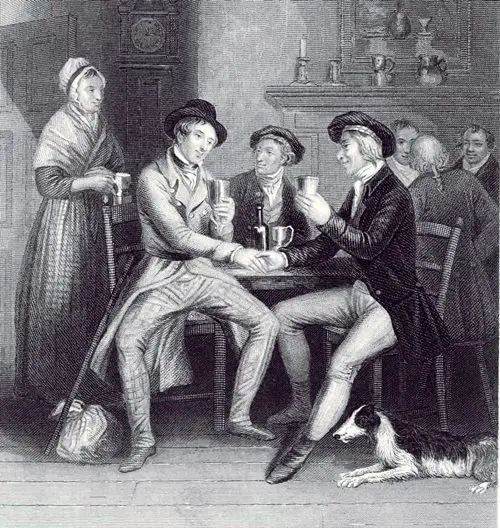
:
“Auld Lang Syne” is a customary Scottish tune that has turned into a notable piece of New Year’s Eve festivities all over the planet. Created by Robert Consumes in the late eighteenth 100 years, the melody brings out sensations of wistfulness, fellowship, and reflection as individuals bid goodbye to the old year and welcome the new. While many are know all about the song and the general importance behind the verses, there are a few less popular realities about “Auld Lang Syne” that add to its rich history and persevering through fame. In this article, we will dive into the main 10 less popular realities about “Auld Lang Syne,” revealing insight into its beginnings, social importance, and the getting through heritage it has made.
Beautiful Starting points:
“Auld Lang Syne” depends on a sonnet composed by the famous Scottish writer Robert Consumes. The sonnet, additionally named “Auld Lang Syne,” was distributed in 1788 in Consumes’ book of verse, “Scots Melodic Exhibition hall.” Consumes drew motivation from customary Scottish society tunes and customs, mixing them with his own melodious virtuoso.
Shared Initiation:
While Robert Consumes is credited with the verses of “Auld Lang Syne,” he recognized that the tune depended on a more seasoned Scottish people song. The words and the tune were consolidated to make the notorious melody we know today.
Importance of the Title:
The expression “Auld Lang Syne” means “old since a long time ago” or “ancient times” in current English. It mirrors the feeling of thinking back about old recollections and old kinships, as well as the progression of time.
Worldwide Acknowledgment:
Albeit “Auld Lang Syne” has profound Scottish roots, it has risen above borders and earned worldwide respect. The tune is sung in different nations all over the planet, especially during New Year’s Eve festivities, representing solidarity and a common feeling of mankind.
Association with New Year’s Eve:
While “Auld Lang Syne” is frequently connected with New Year’s Eve, it was not initially composed as Another Year’s melody. In any case, the melody’s subjects of reflection, recognition, and the progression of time pursue it a fitting decision for saying goodbye to the old year and embracing the upgraded one.
Fame in the US:

“Auld Lang Syne” has acquired huge prominence in the US, especially as a famous tune related with New Year’s Eve festivities. While it started as a customary Scottish people melody, its reception and transformation in American culture have solidified its place as a cherished and generally perceived tune.
The tune’s relationship with New Year’s Eve merriments in the US can be followed back to the mid twentieth hundred years. It turned into a practice to sing “Auld Lang Syne” at the stroke of 12 PM, representing the goodbye to the old year and the inviting of the new. This custom was promoted through radio stations, where audience members the country over would participate in singing the melody to stamp the beginning of another year.
Throughout the long term, “Auld Lang Syne” has become profoundly imbued in American mainstream society. Its consideration in movies and network shows has additionally set its commonality and reverberation. Whether it is highlighted in endearing scenes of reflection or as a scenery for fabulous New Year’s Eve festivities, the melody has become inseparable from snapshots of progress and sentimentality in American diversion.
The melody’s fame stretches out past New Year’s Eve, tracking down its place in other critical occasions and events. It is much of the time sung at graduation functions, representing the goodbye to one section of life and the start of another. Moreover, “Auld Lang Syne” is performed at dedication administrations, giving a powerful and encouraging recognition for the recollections of friends and family who have died.
Artistically, “Auld Lang Syne” has been adjusted and rethought in different classes to take special care of various preferences. Contemporary craftsmen have offered their understandings, mixing the melody with current music styles like pop, rock, and jazz. These variations have assisted with acquainting the melody with more youthful ages and keep up with its significance in the always developing music scene of the US.
Moreover, the melody’s ubiquity has impacted the business area, with accounts of “Auld Lang Syne” being delivered and played during the Christmas season. The melody’s commonality and relationship with New Year’s Eve make it a staple in retail locations, eateries, and other public spaces, further implanting it in American culture.
All in all, “Auld Lang Syne” has accomplished huge prominence in the US, turning out to be profoundly entwined with New Year’s Eve festivities and other critical occasions. Its presence in American movies, TV programs, and business settings has set its acknowledgment and reverberation among the overall population. Moreover, variations and reevaluations of the melody in different melodic classes have assisted with keeping it new and pertinent. Thus, “Auld Lang Syne” has turned into an esteemed piece of American mainstream society, representing the progression of time, reflection, and the festival of fresh starts.
Verses Varieties:

Over now is the right time, “Auld Lang Syne” has seen varieties in its verses, with various variations and translations arising after some time. While the center message and opinion of the tune stay reliable, these varieties add profundity and social subtleties to the melody, mirroring the different manners by which it is praised and performed.
Perhaps of the most prominent variety in the verses of “Auld Lang Syne” is the aftereffect of Robert Consumes’ variation of the conventional Scottish society tune. Consumes, a prestigious Scottish writer, modified the verses in the late eighteenth hundred years to give the tune natural structure is generally perceived today. His rendition underlines topics of companionship, wistfulness, and the progression of time, making a beautiful and reflective tone that has resounded with crowds for a really long time.
Be that as it may, notwithstanding Consumes’ transformation, various areas and societies have fostered their own melodious varieties of the tune. These varieties reflect nearby traditions and customs, adding a remarkable flavor to the exhibition of “Auld Lang Syne” in various regions of the planet. A few varieties might incorporate extra refrains or changed lines, customized to explicit events or social settings.
As of late, contemporary craftsmen and performers have likewise offered their own translations of the melody, bringing about new melodious varieties. These transformations frequently mix the melody with present day subjects and language, while as yet protecting the center pith of “Auld Lang Syne.” These interpretations reinvigorate the tune and make it applicable to more youthful ages, guaranteeing its proceeded with notoriety and significance.
Besides, the social meaning of “Auld Lang Syne” has prompted interpretations of the melody into different languages. These interpretations expect to catch the feeling and significance of the first verses while permitting individuals from various etymological foundations to associate with the melody. Interpreted variants frequently hold the tune and in general design of the melody, considering multifaceted exhibitions and festivities.
It is vital to take note of that while there might be varieties in the verses, the focal message and soul of “Auld Lang Syne” stay in one piece. The melody fills in as a suggestion to value companionships, ponder the past, and embrace what’s in store. No matter what the particular words utilized, the profound reverberation and widespread subjects of the melody keep on contacting hearts and unite individuals in festival and solidarity.
All in all, “Auld Lang Syne” has seen varieties in its verses after some time, mirroring the flexibility and social meaning of the tune. Robert Consumes’ transformation gave a graceful establishment, however territorial varieties, contemporary understandings, and interpretations into various languages have added profundity and variety to the melody. While the verses might contrast, the center message of “Auld Lang Syne” stays reliable, filling in as an immortal suggestion to esteem connections, ponder the past, and praise the bonds that join us.
Image of Solidarity:
“Auld Lang Syne” has developed into an image of solidarity, cultivating a feeling of association and harmony among individuals across societies and ages. The tune’s verses and song convey a general message that rises above language boundaries and resounds with people from varying backgrounds, making it a strong image of solidarity.
The verses of “Auld Lang Syne” talk about recollecting old colleagues and esteeming the common encounters of the past. This opinion of recognition and appreciation for the associations shaped with others is something that individuals from various foundations can connect with. It fills in as an update that notwithstanding our disparities, we as a whole offer a typical humankind and a longing to love the bonds we have manufactured.
The melody’s prevalence during New Year’s Eve festivities all over the planet further stresses its job as a binding together power. As the clock strikes 12 PM, individuals from different societies and nations hold hands and sing “Auld Lang Syne” together, making a feeling of aggregate festival and fortitude. The demonstration of singing the tune as one represents the approaching together of networks, rising above boundaries and encouraging a worldwide feeling of solidarity and generosity.
Also, “Auld Lang Syne” has been acted in worldwide occasions, like the Olympic Games and global get-togethers. During these events, the tune fills in as a binding together hymn that brings individuals from different foundations together. It fills in as an update that, paying little heed to identity or language, we are all essential for a common worldwide local area, and we can settle on something worth agreeing on and association through music and shared customs.
Moreover, “Auld Lang Syne” has turned into an image of solidarity in the midst of difficulty and difficulties. The tune has been sung in snapshots of public or worldwide importance, offering comfort and strength during troublesome times. Whether it is sung in the repercussions of cataclysmic events, during dedication services, or in the midst of social disturbance, the tune goes about as a binding together image, giving a feeling of trust and flexibility despite difficulty.
The getting through prominence and broad acknowledgment of “Auld Lang Syne” add to its job as an image of solidarity. The melody’s commonality and capacity to bring out feelings make a common encounter among individuals, no matter what their social or semantic foundation. Its tune and verses act as an extension that interfaces people, cultivating a feeling of having a place and solidarity that rises above contrasts.
All in all, “Auld Lang Syne” has turned into a strong image of solidarity, uniting individuals and encouraging a feeling of association and harmony. Its verses of recognition and shared encounters resound with people from different foundations, while its notoriety during New Year’s Eve festivities and global occasions further builds up its job as a bringing together song of praise. Through its getting through allure and capacity to bring out feelings, “Auld Lang Syne” has turned into an esteemed image that advances solidarity and helps us to remember our common humankind.
Variations in Mainstream society:
“Auld Lang Syne,” an immortal Scottish people tune, has been adjusted and integrated into mainstream society in different ways, setting its status as a dearest and unmistakable piece of music. Its persevering through bid has prompted various variations in film, TV, writing, and, surprisingly, contemporary music, exhibiting its flexibility and capacity to summon feelings across various mediums.
In film, “Auld Lang Syne” has been highlighted in various famous scenes, frequently filling in as a powerful setting for snapshots of reflection and sentimentality. Whether it is utilized to summon a feeling of yearning or to imply the progression of time, the tune’s consideration in films adds profundity and close to home reverberation. From exemplary movies like “It’s a Superb Life” to present day deliveries, for example, “When Harry Met Sally,” the tune has become inseparable from realistic minutes that catch the quintessence of the human experience.
TV programs have likewise embraced “Auld Lang Syne” as an image of change and contemplation. It is many times used in series finales or New Year’s Eve episodes, permitting characters and watchers the same to think about the excursion and development experienced all through the story. The tune’s presence on TV screens further supports its relationship with huge snapshots of conclusion and fresh starts.
Past visual media, “Auld Lang Syne” has tracked down a spot in writing too. It has been referred to in books, sonnets, and brief tales, adding a hint of commonality and comprehensiveness to scholarly works. Creators use the melody as a device to summon a feeling of immortality or to feature the topical themes of kinship, recollections, and the progression of time. By winding around “Auld Lang Syne” into their stories, scholars tap into its close to home reverberation and interface with perusers on a more profound level.
In contemporary music, specialists have rethought “Auld Lang Syne” through different classifications and translations. Artists across styles like pop, rock, jazz, and traditional have taken the melody’s songs and mixed them with their remarkable styles, reviving the conventional tune. These variations acquaint the tune with new crowds as well as feature its flexibility and persevering through pertinence in the steadily developing scene of famous music.
Moreover, “Auld Lang Syne” is much of the time performed and celebrated in live occasions, for example, New Year’s Eve shows or social celebrations. It fills in as a binding together hymn, rising above social and phonetic limits, as crowds consolidate to sing the natural verses. The melody’s consideration in these occasions builds up its status as an image of collective festival and reflection.
All in all, “Auld Lang Syne” has turned into a basic piece of mainstream society, showing up in film, TV, writing, and contemporary music. Its flexibility and profound reverberation have permitted it to rise above its starting points as a customary Scottish people tune, turning into an all inclusive image of reflection, sentimentality, and fresh starts. Whether it is through its consideration in notorious film scenes, its references in writing, or its reevaluation in different melodic classes, “Auld Lang Syne” keeps on dazzling crowds and keep up with its significance as a loved piece of social legacy.
All year Importance:
“Auld Lang Syne” holds an all year importance as a dearest tune that rises above social limits and has become inseparable from the festival of New Year’s Eve. Beginning from a customary Scottish people tune, the verses and song of “Auld Lang Syne” have persevered for a really long time, conveying significant opinions of fellowship, reflection, and the progression of time.
The melody’s getting through prominence lies in its capacity to summon a feeling of wistfulness and consideration, pursuing it a fitting decision for different events over time. While it is generally usually connected with saying goodbye to the old year and inviting the new, “Auld Lang Syne” reverberates with individuals during other huge minutes too.
One of the critical topics of “Auld Lang Syne” is the festival of fellowship and kinship. It prompts people to ponder the bonds they have framed with others and to offer thanks for the associations that have endured everyday hardship. Thusly, the tune is frequently heard at get-togethers like weddings, graduations, and reunions, where it fills in as a sign of the persevering through force of fellowship and the significance of treasuring those connections.
Besides, “Auld Lang Syne” conveys an all inclusive message of recognition and reflection. Its verses welcome people to stop and think about the past, recognizing the encounters, challenges, and delights that have formed their lives. The tune empowers an aggregate feeling of reflection and restoration, moving people to convey forward the examples gained from the past into the future, no matter what the season.
The tune’s song, portrayed by its basic yet powerful plan, further adds to its all year importance. Its ageless and effectively conspicuous tune makes it versatile to different melodic translations and fits exhibitions across various sorts and societies. Whether it is sung by an ensemble, performed by an orchestra symphony, or played on customary instruments, the song of “Auld Lang Syne” resounds profoundly with audience members, rising above language boundaries and social contrasts.
Besides, “Auld Lang Syne” has turned into an image of worldwide solidarity and fellowship. It is much of the time sung at worldwide occasions, like the Olympic Games or global social events, where it fills in as a binding together song of praise that brings individuals from various foundations and ethnicities together in a common snapshot of reflection and festivity.
All in all, “Auld Lang Syne” holds an all year importance as an immortal tune that praises fellowship, reflection, and the progression of time. Its general subjects and tune make it pertinent past the New Year’s Eve custom, permitting it to reverberate with individuals during snapshots of festivity, recognition, and solidarity consistently. As people hold hands and sing its recognizable verses, “Auld Lang Syne” keeps on exemplifying the persevering through soul of human association and the force of shared encounters, reminding us to esteem the past, embrace the present, and anticipate what’s in store.
End:
“Auld Lang Syne” is an immortal and darling tune that rises above social limits and holds an extraordinary spot in the hearts of individuals all over the planet. Its graceful beginnings, global acknowledgment, and relationship with New Year’s Eve festivities have made it a getting through piece of our shared mindset. As we sing the recognizable song and consider the progression of time, “Auld Lang Syne” keeps on helping us to remember the significance of companionship, solidarity, and loving the recollections we hold dear.

